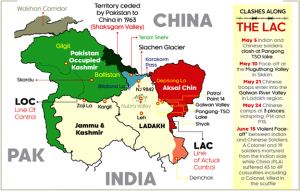TAG: GS 2: INTERNATIONAL RELATIONS
THE CONTEXT: India has vehemently condemned China’s attempts to include the Shaksgam valley in its territory. The Ministry of External Affairs (MEA) spokesperson expressed India’s rejection of China’s actions and registered a strong protest against what India perceives as illegal attempts to alter the territorial status quo.
EXPLANATION:
- India asserts that it has never accepted the China-Pakistan boundary agreement of 1963, through which Pakistan purportedly attempted to cede the Shaksgam valley to China.
- This rejection underscores India’s stance on the territorial integrity of the region and its refusal to acknowledge any agreements that infringe upon its sovereignty.
Strategic Significance of the Shaksgam Valley
- The Shaksgam valley holds strategic importance, situated in Pakistan-occupied Kashmir (PoK).
- Its proximity to Siachen Glacier, a region of ongoing territorial dispute between India and Pakistan, adds to its geopolitical significance.
- China’s reported construction activities in the area raise concerns regarding its intentions and potential implications for regional stability.
China’s Incursion and Construction Activities
- Reports indicate that China has breached roads into the Indian border at Aghil Pass and entered the lower Shaksgam valley of Kashmir.
- Satellite imagery reveals construction activities, including the building of roads, indicating China’s efforts to assert control over the region.
- The proximity of these activities to Siachen Glacier heightens security concerns for India.
Historical Context of the Shaksgam Valley
- The Shaksgam valley was illegally ceded by Pakistan to China in a controversial 1963 boundary agreement.
- This agreement, which India does not recognize, facilitated the transfer of territory from Pakistan to China without India’s consent.
- India’s rejection of this pact reflects its commitment to safeguarding its territorial integrity and challenging any unilateral attempts to alter borders.
Escalation of Tensions
- China’s incursions into the Shaksgam valley represent a continuation of its assertive behavior in territorial disputes.
- India’s response indicates its readiness to defend its interests and sovereignty, signaling the potential for heightened tensions in the region.
- The situation underscores the complexities of geopolitical dynamics in South Asia and the challenges of managing border disputes effectively.
Shaksgam valley:
- The Shaksgam Valley, or Trans Karakoram Tract, is part of the Hunza-Gilgit region of Pakistan-Occupied Kashmir (POK) and is a disputed territoryclaimed by India but controlled by Pakistan.
- It borders Xinjiang Provinceof the People’s Republic of China (PRC) to the north, the Northern Areas of POK to the south and west, and the Siachen Glacier region to the east.
- It was ceded to China by Pakistanin 1963, when both countries signed a boundary agreement to settle their border differences.
- However, Article 6 ofthe agreement clearly stated that “the two parties have agreed that after the settlement of the Kashmir dispute between Pakistan and India, the sovereign authority concernedwill reopen negotiations with the Government of the People’s Republic of China, on the boundary as described in Article Two of the present agreement, so as to sign a formal Boundary Treaty to replace the present agreement.”
- The agreement laid the foundation of Karakoram highway, which was built jointly by Chinese and Pakistani engineers in the 1970s.

Shaksgam Valley
Spread the Word

